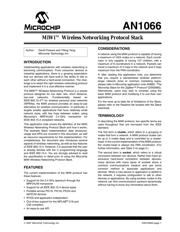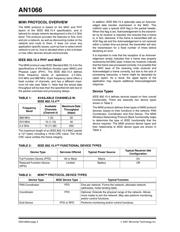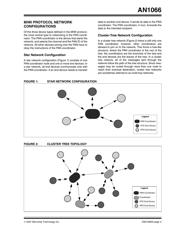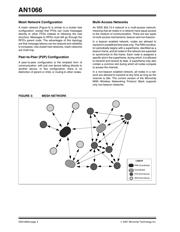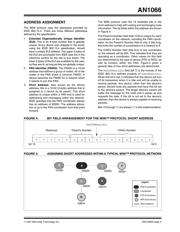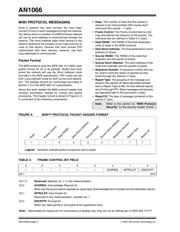Datasheet 搜索 > 微控制器 > Microchip(微芯) > PIC16F73-I/SO 数据手册 > PIC16F73-I/SO 开发手册 1/40 页
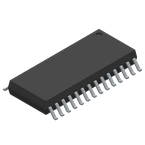
 器件3D模型
器件3D模型¥ 32.342
PIC16F73-I/SO 开发手册 - Microchip(微芯)
制造商:
Microchip(微芯)
分类:
微控制器
封装:
SOIC-28
描述:
MICROCHIP PIC16F73-I/SO 微控制器, 8位, 闪存, PIC16F, 20 MHz, 7 KB, 192 Byte, 28 引脚, SOIC
Pictures:
3D模型
符号图
焊盘图
引脚图
产品图
页面导航:
功能描述在P1P2P17P22P28P36
导航目录
PIC16F73-I/SO数据手册
Page:
of 40 Go
若手册格式错乱,请下载阅览PDF原文件

© 2007 Microchip Technology Inc. DS01066A-page 1
AN1066
INTRODUCTION
Implementing applications with wireless networking is
becoming commonplace. From consumer devices to
industrial applications, there is a growing expectation
that our devices will have built-in the ability to talk to
each other without a hard-wired connection. The chal-
lenge is to select the right wireless networking protocol
and implement it in a cost-effective manner.
The MiWi™ Wireless Networking Protocol is a simple
protocol designed for low data rate, short distance,
low-cost networks. Fundamentally based on
IEEE 802.15.4™ for wireless personal area networks
(WPANs), the MiWi protocol provides an easy-to-use
alternative for wireless communication. In particular, it
targets smaller applications that have relatively small
network sizes, with few hops between nodes, using
Microchip’s MRF24J40 2.4 GHz transceiver for
IEEE 802.15.4 compliant networks.
This application note covers the definition of the MiWi
Wireless Networking Protocol Stack and how it works.
The example Stack implementation data structures,
usage and APIs are covered in this document, as well
as resource requirements for this implementation. For
completeness, the document also introduces several
aspects of wireless networking, as well as key features
of IEEE 802.15.4. However, it is assumed that the user
is already familiar with the C programming language
and IEEE 802.15.4. You are strongly advised to read
the specification in detail prior to using the Microchip
MiWi Wireless Networking Protocol Stack.
FEATURES
The current implementation of the MiWi protocol has
these features:
• Support for the 2.4 GHz spectrum through the
MRF24J40 transceiver
• Support for all IEEE 802.15.4 device types
• Portable across PIC16, PIC18, PIC24 and
dsPIC33 devices
• RTOS and application independent
• Out-of-box support for the MPLAB
®
C18 and
C30 compilers
• An easy-to-use API
CONSIDERATIONS
A network using the MiWi protocol is capable of having
a maximum of 1024 nodes on a network. Each coordi-
nator is only capable of having 127 children, with a
maximum of 8 coordinators in a network. Packets can
travel a maximum of 4 hops in the network and 2 hops
maximum from the PAN coordinator.
If, after reading this application note, you determine
that you require a standardized wireless platform,
larger network sizes or common marketing logos,
please refer to Microchip application note
AN965, “The
Microchip Stack for the ZigBee™ Protocol”
(DS00965).
Alternatively, users may wish to consider using the
basic MiWi protocol and modifying it to suit their own
applications.
For the most up-to-date list of limitations of the Stack,
please refer to the Readme file located with the Stack
download.
TERMINOLOGY
In describing the MiWi protocol, two specific terms are
used throughout that are borrowed from the IEEE
standard.
The first term is cluster, which refers to a grouping of
nodes that form a network. A MiWi protocol cluster can
be up to 3 nodes deep and is controlled by a cluster-
head. In the current implementation of the MiWi protocol,
the cluster-head is always the PAN coordinator. (For
further information, see Table 3 on page 2.)
The second term is socket, which refers to a virtual
connection between two devices. Rather than have an
exclusive hard-wired connection between devices,
many devices with many types of sockets share a
common communications medium and use some
common method to associate applications and
devices. When a new device or application is added to
the network, it requires configuration to talk to other
devices or applications. By using sockets, nodes in the
network can find communication partners dynamically
without having to know any information about them.
Author: David Flowers and Yifeng Yang
Microchip Technology Inc.
MiWi™ Wireless Networking Protocol Stack
器件 Datasheet 文档搜索
AiEMA 数据库涵盖高达 72,405,303 个元件的数据手册,每天更新 5,000 多个 PDF 文件
